Your training scenario begins in a darkened room with your Nomex® hood placed over your mask, creating zero visibility. Your assignment is to crawl through a maze as you have done many times before at this training location. You start with a right-hand search and enter. After making two left-hand turns, you come to a set of stairs, where you turn and go down feetfirst. Continuing on that wall, you come to a simulated floor collapse. After exiting the floor collapse, you have to navigate a reduced profile opening by using a swim technique maneuver. Once that task is completed, you take two more turns and you come to another reduced profile opening; however, you are breathing heavily and becoming exhausted, and you have to remove your self-contained breathing apparatus (SCBA) bottle to make it through this obstacle.
Does this training scenario sound familiar? For many, when we train, we use simulators, which allow for little, if any, change. Regardless of how good a prop is, it’s still a prop. By being too familiar with our training simulators, we also become complacent in our training—knowing what to expect and when to expect it.
RELATED FIREFIGHTER TRAINING
Maximizing Training Evolutions in an Acquired Structure
ACQUIRING STRUCTURES FOR TRAINING
TRUCK COMPANY DRILLS AT ACQUIRED STRUCTURES
By using acquired structures, you can be as creative as you want for many different types of scenarios. Whether the drill is search and rescue, forcible entry, rapid intervention team (RIT), fire attack, vertical ventilation, safety and survival, or any other type of training, acquired structures give you the ability to do something different every time you train (photos 1-5).
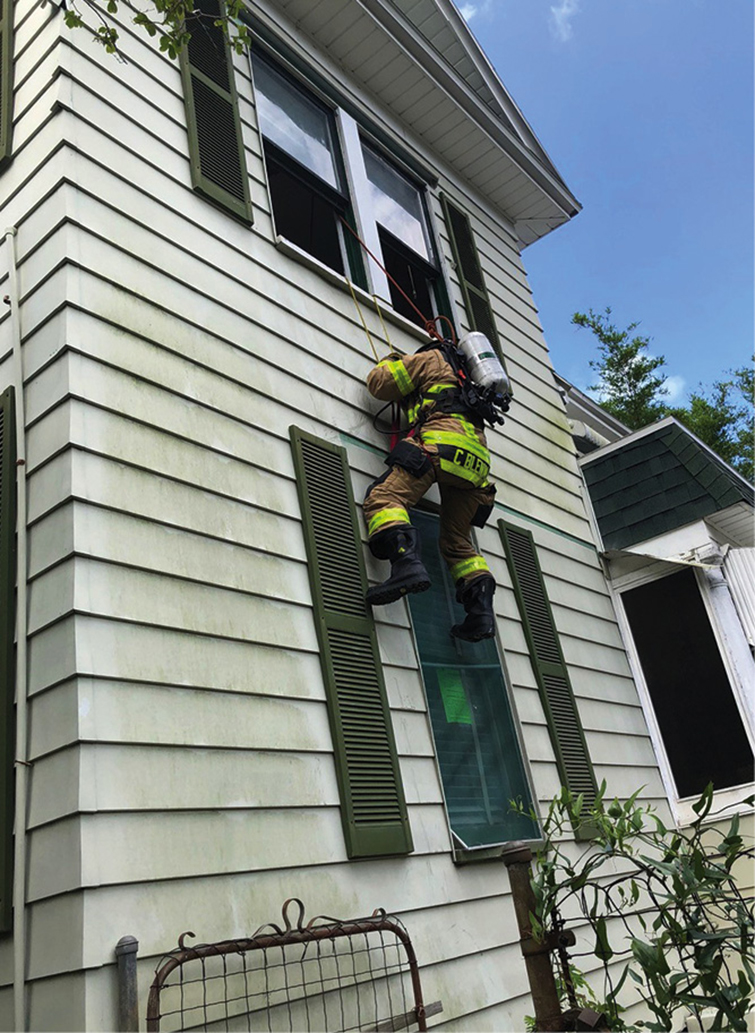
(1) Crews were able to take advantage of a two-story home to practice safety and survival drills, including window bailouts. (Photos by William Townsend unless otherwise noted.) (

(2) Firefighters were able to make multiple cuts on a metal garage door, which enhanced their power tool skills.

(3) We can improve our most common skills such as hoseline management by drilling in homes that still contain furniture and other obstacles.
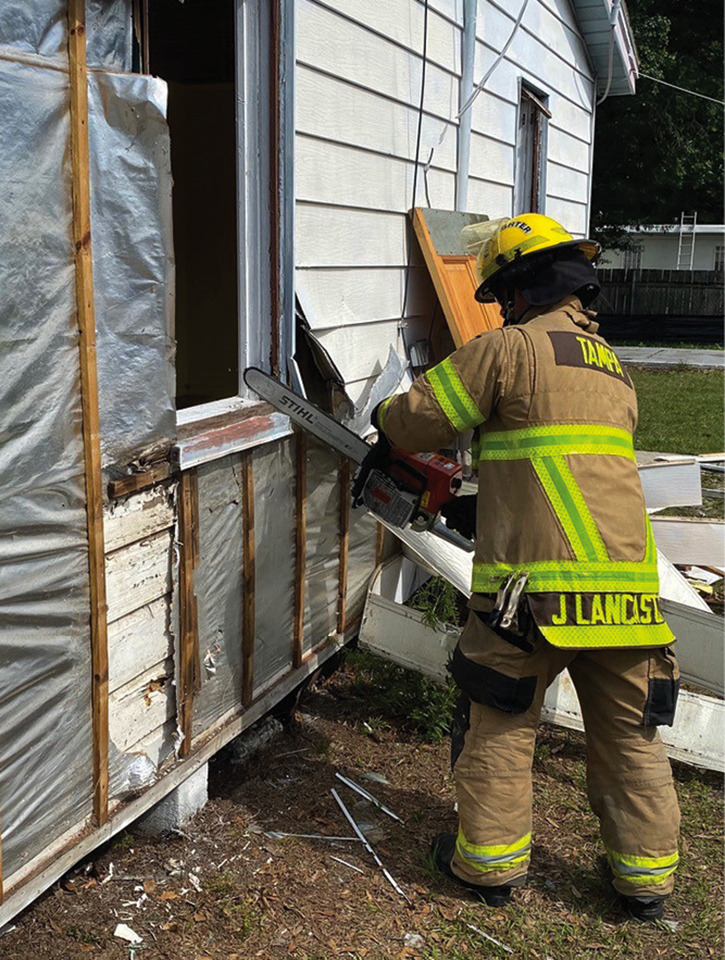
(4) Unique RIT skills were introduced, and firefighters practiced converting windows to doors with hand and power tools.

(5) Vertical ventilation and building construction skills can be practiced on almost every home acquired.
It’s critical that you review the structure and your training objectives within the context of National Fire Protection Association 1403, Standard on Live Fire Training Evolutions. Use the standard as a checklist to verify compliance, particularly all safety requirements.
The Tampa (FL) Fire Department has been fortunate enough to establish partnerships with several builders within our city limits. These builders have agreed to allow us to train on properties scheduled for demolition. Although these are residential properties, there are no two alike. Generally, the properties are available for anywhere from one week to several months, allowing multiple crews to use them.
How Did We Get Here?
The City of Tampa’s legal team put together a hold harmless agreement, which was then put forth before the City Council for approval. Prior to having this agreement, every property had to go before City Council for individual approval. This could delay the use of a structure anywhere from one to three months. At that time, residential properties were not even a consideration because most were torn down before the paperwork could be completed. This standard paperwork has been the template for the use of commercial properties as well. Having this current system in place allows for most properties to become available within a week of the paperwork being submitted by the builders. In the future, the City of Tampa will be going to an electronic signature system, which will speed the process up even more.
Benefits Twofold
Community benefits. The ability to train in acquired structures allows for realistic, creative training that develops better firefighters. This training also places the fire companies out in the public eye, in the neighborhoods, when training on homes. On more than one occasion, we have had families set up lawn chairs with their children to watch the training. Public relations are also established for the builders, who sometimes have come under scrutiny when building in historic neighborhoods. Neighbors see the homes being put to good use before their demise.
Another benefit to the community is often the previous owners leave items behind. Many of these items have been donated to local shelters and other charitable organizations.
Department benefits. Tampa Fire has benefited by training on ventilation, RIT, search and rescue, fire attack and fire line management, forcible entry, and building construction. These homes also are good for multicompany drills, which allow for command scenarios. While at this time Tampa Fire does not use them for live-fire training, it could always be a future option.
What Makes a Home Useful?
Almost every home has some value. During the two years of training under this program, Tampa Fire has taken advantage of more than 100 homes, and less than a handful of homes have been turned down because of poor conditions. In the case of the occasional hoarder home, we may only use the roof for ventilation and the doors for forcible entry. If items left in the homes have no useful value, they can be arranged to enhance the simulated training. All homes are inspected prior to training. Roofs and floors are checked for stability. It is also important to note that all homes are left secured on completion of training evolutions.
The majority of homes in our city have asphalt shingles. With this program, we have had the opportunity to work with the less common barrel-tile and metal tin roofs as well. This allows crews to ventilate as well as learn about building construction unique to those roofs.
Windows can, at times, be a challenge. As simple as it may sound to break glass, the challenges of hurricane-rated storm windows lead to another level of training. They are a rare find in a donated home, but we have been lucky to come across a few homes with these windows. We have removed many of them to use in a window prop for future training. In addition to the occasional storm window, we often get homes with burglar bars. These have helped us realize they often are easier to defeat than we expected.
Forcing doors is a good drill to do in these homes. The interior doors, while simple to force, can be used to teach the technique prior to attempting a more challenging exterior door. We can resecure the doors after use with three-inch drywall screws, allowing for multiple drill opportunities.
Safety and survival/RIT drills are limitless. The different floor plans allow for a different drill each time. We can breach walls, perform window bailouts, and run creative search and rescue drills.
The Process
First, work with your municipality’s legal team to create paperwork that you can use for each address (this may vary by municipality on a per-address need vs. a per-builder need). Anytime you are out on the road and see a building or home for sale, it’s as simple as a phone call to the number posted. Introduce yourself and inquire about the future use of the property. If it’s scheduled for demolition, explain what you would like to use the property for before it’s torn down. Make sure to explain the benefits to your department. Everyone loves to assist the fire department when possible.
Also, it’s important to find out if the builders take ownership of the property. If they don’t, the paperwork will have to go to the owner, which can delay using it. If you have builders building numerous homes in your area, they should be your targets. We have a fantastic legal team who has even adjusted the paperwork to accommodate different builders.
Once a relationship is established, it’s as easy as forwarding the addresses to your point person for dissemination. In our notification, we often include items that may be beneficial to the training property—e.g., a fire hydrant close by, a unique roof type, or the presence of burglar bars (photos 6-8).
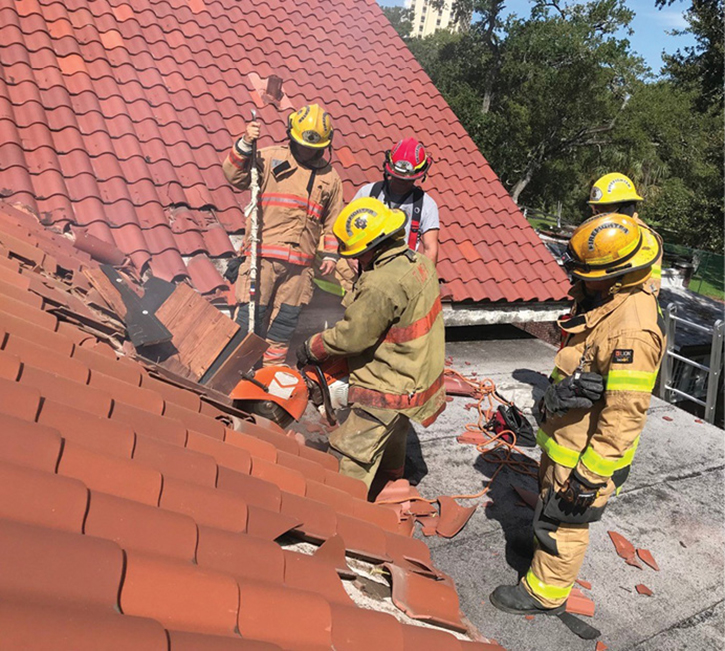
(6) It’s rare to have the opportunity to train on a barrel-tile roof. This drill allowed crews to see the simplicity in its removal as well as the method used for its assembly.
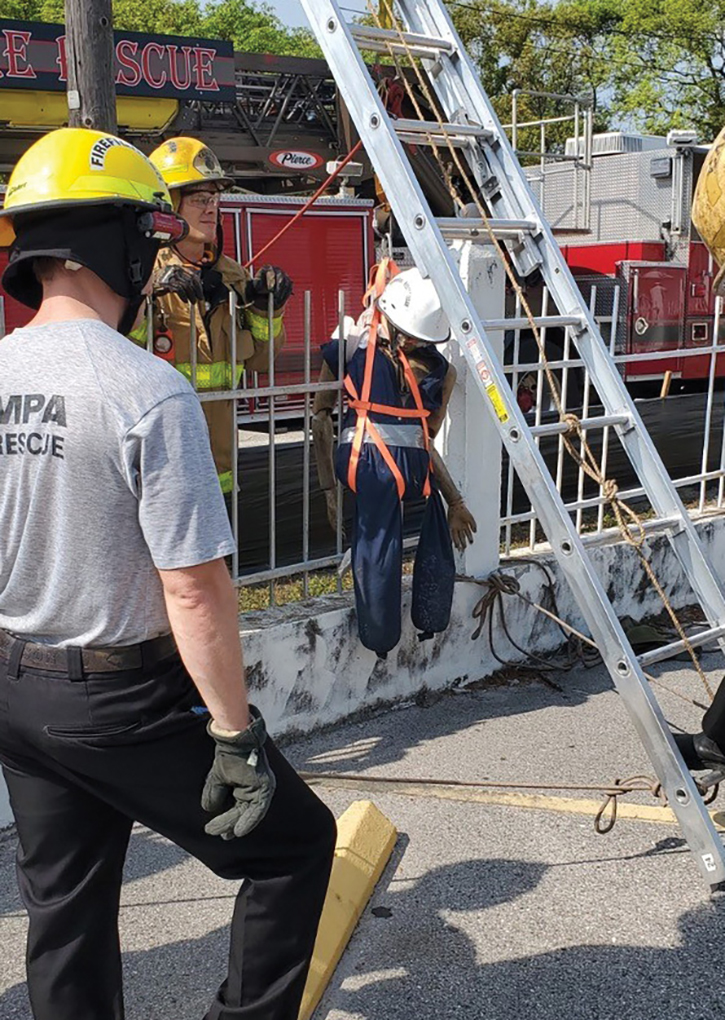
(7) Tampa’s Heavy Rescue Team was able to take advantage of a steel fence in the removal of an impaled “victim.”
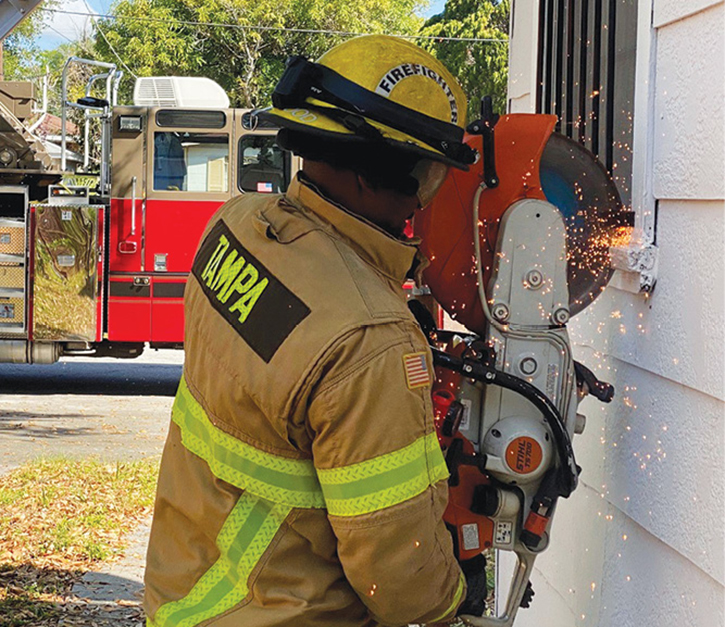
(8) We have been fortunate to have many homes with burglar bars, which allow us to train with power and hand tools in their removal.
We let St. Pete Fire, our neighbor across the bay, use some of our homes, and our builder provided homes local to St. Pete as well.
Regardless of the steps necessary to make it happen, training in acquired structures is invaluable. The upfront legwork will be beneficial in the long run. Our process took several years to get where it is now and has been well worth the time invested.
Tips When Training in Acquired Structures
In our city, we have many homes that are wood frame and sit off the ground. In this case, it’s a good idea to punch small holes in the floor with a halligan or pickhead ax to allow for drainage when flowing water. Keeping windows open during fire attack also helps reduce water accumulation.
Securing homes is as easy as using three-inch drywall screws to secure doors. You can remove interior wall studs to secure doors as well. We often use old interior doors to cover window openings when windows are removed. We generally leave holes in rooftops as is.
Builders have provided signs displaying their logo along with the fire department’s announcing the upcoming training, which helps put the neighbors at ease when they see the fire trucks show up and firefighters in full gear get off the trucks with tools in hand (photo 9).
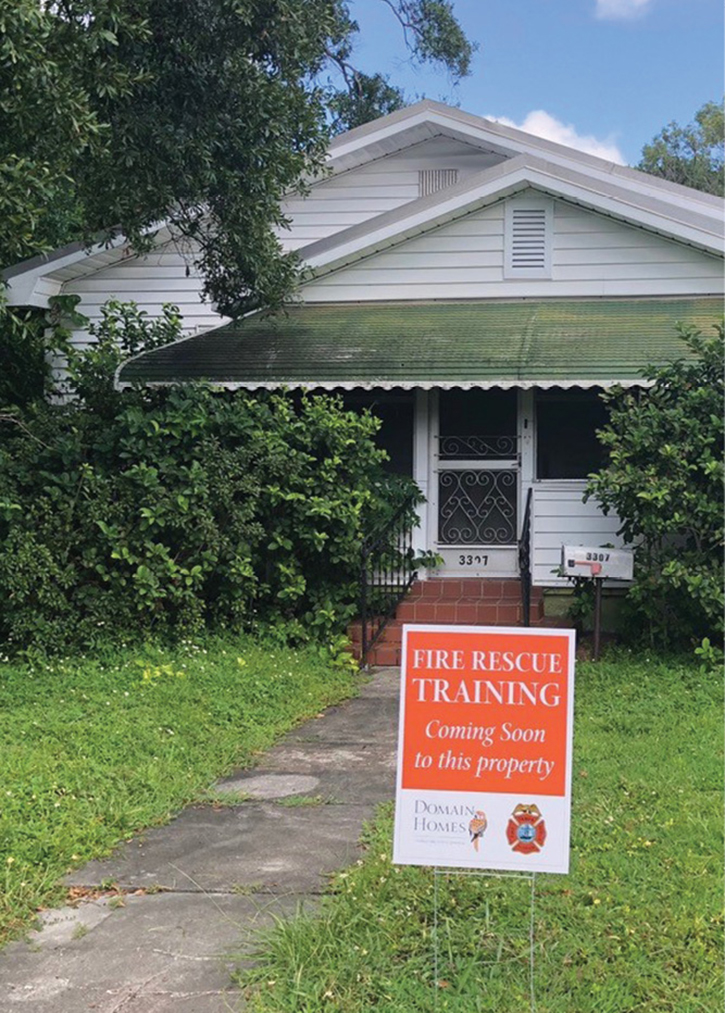
(9) Builders have provided yard signs announcing the upcoming training. This has led to very positive public relations for both the fire department and the builders.
Reality-Based Training
There is no greater benefit to the troops than realistic live training. There is an old saying in the fire service, “You play the way you practice.” These words cannot be more true with regard to how firefighters train to perform their duties. Acquired structures will be beneficial to firefighters because “if the hands-on training lacks the reality factor, the firefighters will either discount it entirely or will minimize its importance.”1 This is where the acquired structures will be beneficial to the firefighters.
Acquired structures provide the opportunity for reality-based training. We were fortunate enough to have a single-story church in our district that allowed our members a chance to perform several scenarios that would reinforce basic skills. We used the sanctuary for commercial fire attack, and the roof was sectioned into three parts for roof ventilation by A, B, and C shifts (photo 10). The scenario we used was that a first-arriving engine company would pull a 2½-inch handline for an interior fire attack in the sanctuary. They were met with the challenges of advancing the handline into a completely carpeted and furnished sanctuary (photos 11, 12). This is a different setup than what normally takes place during routine training sessions. Typically, training is done in a wide-open parking lot or in an unobstructed smooth floor training building.

(10) Tampa Fire recently completed training on a small community church. The roof was divided up to allow all shifts to share in the training opportunities. (Photos 10-13 by David Dittman.)
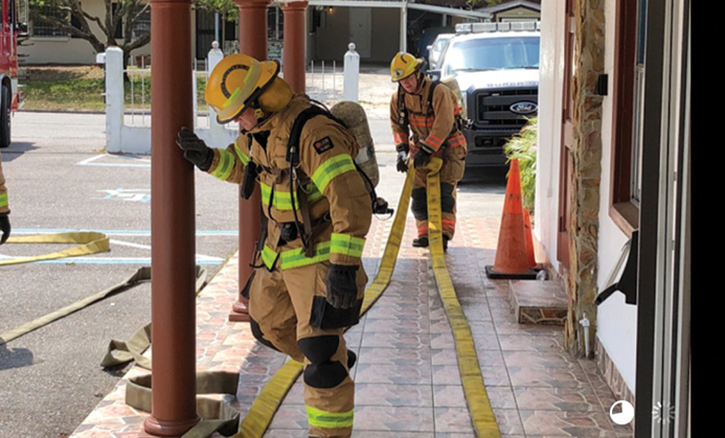
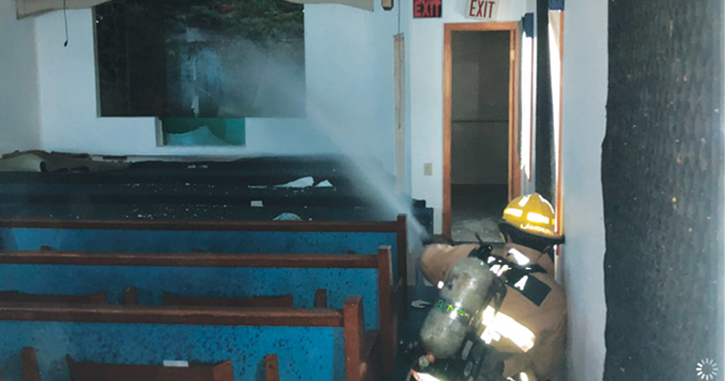
(11, 12) The church sanctuary allowed for simulation of a commercial structure; we were able to conduct multiple fire attacks using 2½-inch lines.
There was an attached classroom inside the church that we kept sterile so we could use it for a down firefighter RIT scenario. The basic scenario was a single-story residential structure fire, and the companies were assigned the role of RIT on the fireground. The instructions were to assemble the tools necessary to perform a RIT function and stand by for assignment. We used a hose dummy dressed as a firefighter in full bunker gear and SCBA with a face piece and staged the dummy in the classroom. The personal alert safety system device was set off and a Mayday transmission was executed over the portable radio. Command dispatched the RIT to enter the structure and search for the down firefighter (photo 13). The crews had to work together under a stressful situation to find and retrieve the firefighter. The benefit of this drill was the realistic scenario allowed us to identify areas where crews excelled and areas that the company officers needed to go back to the firehouse to review techniques and procedures with their companies.
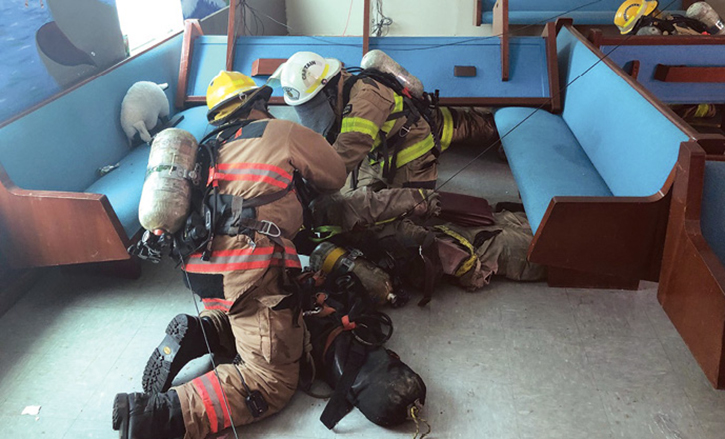
(13) The classroom portion of the church was kept sterile to allow for RIT training with the use of an outfitted mannequin.
The district chief, training chief, or another designated chief has the logistical responsibility to make sure the training drills are clearly defined and outlined so companies can arrive, receive a quick briefing, and get to work on training. The run volumes the fire service faces today make placing companies out of service for realistic training more and more difficult. A good rule of thumb for all companies is to follow SMART (Sixty Minutes Available for Realistic Training).1 By preplanning, scheduling, and having an outline agenda, the companies can go out of service, arrive on the training site, and maximize their time to train on the acquired structure. The total time out of service typically is under three hours, which is less than our normal scheduled training classes of four hours.
Endnote:
1. Bernocco, M; Gagliano, M; Jose, P; Phillips, C. (2008). Air Management for the Fire Service. Tulsa, OK: PennWell.
WILLIAM TOWNSEND is a 29-year veteran of the fire service and a captain for Tampa (FL) Fire Rescue Truck 9. He is a Fire Officer II; a Fire Instructor III with Learey Vo-Tech and St. Pete College; and a founder of Friends of Tampa Firefighters, where he is the lead instructor for the Company Officer class.
DAVID DITTMAN is a 24-year fire service veteran and a district chief for Tampa (FL) Fire Rescue District 2. He is a Fire Officer III; a Fire Instructor III with Learey Vo-Tech; and a founder of Friends of Tampa Firefighters, where he is the lead instructor for Tactics II and the Burn Master for live-fire training.

